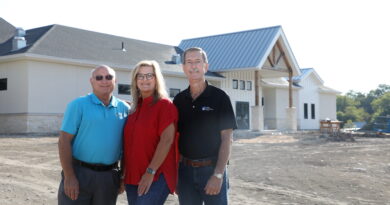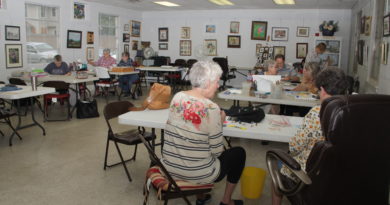Book chronicles a day of destruction in Texas town
By Catherine Hosman
The afternoon of Jan. 23, 1913, was unusually busy for the shops on the square in McKinney, Texas, especially at the Cheeves Brothers Mississippi Store where a sale was in progress.
 Customers flowed in and out throughout the day. Nine employees were on staff to serve the mostly female customers who were shopping for intimate apparel on sale.
Customers flowed in and out throughout the day. Nine employees were on staff to serve the mostly female customers who were shopping for intimate apparel on sale.
The Mississippi Store occupied the first two floors of a three-story building owned by the local chapter of the Odd Fellows. The store also shared a wall with its neighbor to the west, the two-story Tingle Implement Store owned by Thomas Jefferson Tingle.
“Tingle, who advertised himself as the ‘Implement Man,’ moved to McKinney in 1911 from Childress, Texas,” writes Carol O’Keefe Wilson, author of The 1913 McKinney Store Collapse, published by Arcadia Press and The History Press. “He rented both floors of the building, operating his farm implements store on the lower level and using the upper floor for storage.”
Around 3:40 p.m. the crowd in the Mississippi Store began to thin. Employee Annie Curts watched as the last few customers were being taken care of; but something wasn’t right. Suddenly she felt a shift in the three-story building.
“The wall seemed to bulge slightly, and a menacing noise, like a muffled chorus of squeaks, set off an alarm in her mind,” writes Wilson. “As quickly as her body could react to the signal of danger, Annie dove to the floor behind the counter, covering her head. In an instant, the walls and floors above came crashing down around her with a thunderous roar she later compared to the sound of a cyclone.”
Wilson, who has written two other books on Texas history, was researching the Cheeves brothers for her next book, when she heard of the McKinney store collapse. The Cheeves family had several stores in Central Texas, including a store in downtown Temple that operated for 70 years. “When I was looking for an idea to do a book, I came to this story,” she says.
She visited the McKinney museum and shared her idea for the book with the staff. “They felt it would be well received,” she says.
It took Wilson a year to research and write the story. It took another seven months for the book to be published. Through her diligent research and carefully sourced illustrations, she takes you through every moment leading up to the collapse of the two connected buildings on the square. Her description of the collapse and the people who perished or escaped gives you the sense that you are present on the square, standing on the opposite side of the street from the disaster. You can feel the rumble of the earth before the buildings came crashing down, hear the cries of the people trapped inside and feel the effects of the dust as the cloud of debris settled in the street. Five women, two men and one child died, including Robert Norman Presley, a young clerk. Fifteen people were injured.
When Wilson decided to shift gears away from her original idea about the Cheeves brothers and write this historical book, she says her goal was to emphasize the victims. “They are not props in this story. The other emphasis is on the history,” she says. “I’m not trying to sensationalize this tragedy; I’m using it as a vehicle to bring attention to these people.”
She dedicated her book to Presley, who left behind a wife and young daughter when he perished in the collapse. “In the initial news stories after the accident they printed a picture of six of the victims. He was one of them, but his photo never appeared in the paper,” Wilson explains. “He suffered the most. He was the saddest case.”
Wilson’s book captures the essence of this historic event that occurred at the dawn of the 20th century to share with readers in the second decade of the 21st century. Wilson’s writing makes you feel as if you were there. She talks about the prehistory of that deadly day and the aftermath of the suffering so many families endured in this close-knit town where everybody knows their neighbor or are related.


